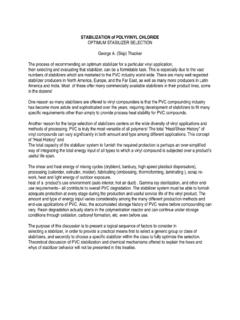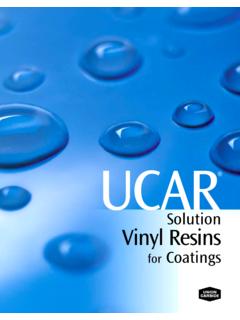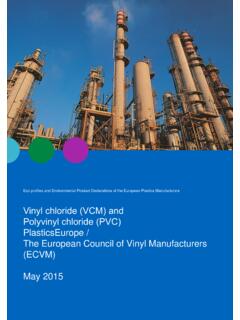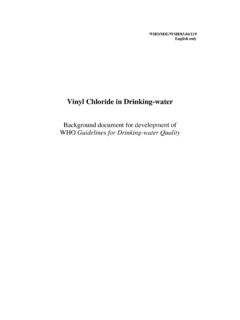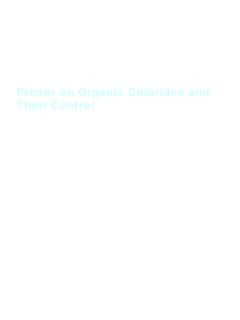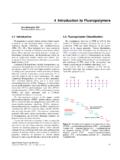Transcription of 2. IDENTITY, PHYSICAL AND CHEMICAL …
1 132. IDENTITY, PHYSICAL AND CHEMICALPROPERTIES, AND ANALYTICAL METHODSThis monograph deals with vinyl chloride (VC) monomer itselfand is not an evaluation of polyvinyl chloride (PVC), the polymer IdentityChemical formula:C2H3 ClChemical structure:H2C=CHClRelative mass:Common names: vinyl chlorideCAS CHEMICAL name:Ethene, chloro-IUPAC name:ChloroetheneCAS Registry75-01-4 number:EC Number:602-023-007 EINECS Number:2008310 Synonyms: vinyl chloride monomer , monochloro-ethene; monochloroethylene; 1-chloro-ethylene, chloroethene, (by weight); water: mg/kg; HCl: max. 1 mg/kg(BUA, 1989)Up to the 1960s the purity was not sohigh (Lester et al., 1963)Typical trace10 100 mg/kg range: chloromethane, componentschloroethane; 1 10 mg/kg range: ethyne(acetylene), 1,3-butadiene, butene,1,2-dichloroethane, ethene, propadiene(allene), propene, 1-butyne-3-ene (vinylacetylene) (BUA, 1989)EHC 215: vinyl PHYSICAL and CHEMICAL propertiesSome PHYSICAL properties of VC are given in Table 1.
2 Underambient conditions, vinyl chloride is a colourless, flammable gas witha slightly sweet odour. It is heavier than air and has relatively lowsolubility. There are discrepancies in the literature with regard toHenry's Law constant (air-water partition coefficient, Hc). Whereassome authors give a value between 1 and 3 , other sourcesquote a value two orders higher. Large uncertainties in the absoluteaqueous solubility in older studies probably contribute most to thesediscrepancies (Ashworth et al., 1988). It is an azeotrope with parts water/100 parts vinyl chloride (B nnighausen, 1986;Rossberg et al., 1986). VC is soluble in almost all organic it is a gas that is heavier than air, VC can spread over theground creating an exposure long distances away from the originalsource and can form explosive mixtures. The odour threshold valueis very subjective (see Table 1) and is far above the present acceptedoccupational safety threshold values (see Annex 1).
3 VC is transported as a compressed liquid. As it does not tend topolymerize easily, liquid VC (in the absence of oxygen and water) canbe stored and transported without polymerization inhibitors(B nnighausen, 1986).At ambient temperatures in the absence of air, dry purified VC ishighly stable and non-corrosive. Above 450 C, partial decompositionoccurs yielding acetylene, hydrogen chloride and trace amounts of2-chloro-1,3-butadiene (chloroprene) (Rossberg et al., 1986). Thisreaction also occurs by lower temperatures (at 30 C and under) in thepresence of sodium or potassium hydroxide (B nnighausen, 1986).Combustion of VC in air produces carbon dioxide and hydrogenchloride. Under oxygen deficient conditions, traces of phosgene maybe formed (Rossberg et al., 1986). In chlorine-atom-initiated oxidationof VC, the vinyl chloride peroxide formed decomposes toformaldehyde, hydrogen chloride and carbon monoxide (Bauer &Sabel, 1975; Sanhueza et al.)
4 , 1976).Identity, PHYSICAL and CHEMICAL Properties, Analytical Methods_____15 Table 1. Some PHYSICAL and CHEMICAL properties of vinyl chlorideMelting point CB nnighausen (1986);Dreher (1986)Boiling point CB nnighausen (1986); (at kPa)Dreher (1986)Flash point 78 CB nnighausen (1986); (open cup)Dreher (1986)Autoignition472 CB nnighausen (1986); temperatureDreher (1986)Critical temperature156 CB nnighausen (1986);Dreher (1986)Critical pressure5600 kPaB nnighausen (1986);Dreher (1986)Explosion limits in vol%B nnighausen (1986)in air (20 C);4 22 vol%Dreher (1986)Decomposition450 CB nnighausen (1986) temperatureDensity (20 C) g/cm3B nnighausen (1986)Vapour pressure at 20 C78 kPaDreher (1986) 0 C165 kPa 20 C333 kPaSolubility of VC in water; wt% ( g/litre)DeLassus & Schmidtextrapolated from lowover temperature(1981)pressure experimentsrangeover range 15 85 g/litreEuro Chlor (1999)at 20 CSolubility of ml ( 20 C)B nnighausen (1986) in 100 g ml (+ 20 C)Henry's Law at CGossett (1987) (Hc) ( ) at 25 CAshworth et al.
5 (1988) at 20 CEuro Chlor (1999)Solubility in organicsoluble in mostDreher (1986) solventsorganic liquids andsolvents;insoluble in lowerB nnighausen (1986)polyalcoholsEHC 215: vinyl Chloride_____16 Table 1 (contd).log n- (measured;BUA (1989) partition coefficient22 C) (log Kow) (calculated)BUA (1989) et al. (1983)Odour threshold value26 52 mg/m3 byHori et al. (1972)some, but by all at2600 mg/m3650 mg/m3 Baretta et al. (1969)10 700 mg/m3 Patty (1963)With air and oxygen, very explosive peroxides can be formed(Rossberg et al., 1986). There are reports of explosions in vinylchloride plants (Terwiesch, 1982). In VC recovery plants there is ahigher chance of explosion, which necessitates continuous monitoringand limitation of the oxygen reactions to form PVC are the most importantreactions from an industrial view (see section ).nH2C = CHCl 6 ( H2C CHCl )n; )HR = kJ/molThe reaction is exothermic.
6 Addition reactions with other halogensat the double bond, for instance, to yield 1,1,2-trichloroethane or1,1-dichloroethane, are also important. Catalytic halogen exchange byhydrogen fluoride gives vinyl fluoride (Rossberg et al., 1986). In thepresence of water, hydrochloric acid is formed which attacks mostmetals and alloys. This hydrolysis probably proceeds via a peroxideintermediate (Lederer, 1959). vinyl chlorine reacts with chlorine to form ,1-Dichloroethane is formed from the exothermal reaction of VCwith hydrogen chloride in the presence of iron Conversion factors1 ppm = mg/m3 at 20 C and kPa1 mg/m3= ppmIdentity, PHYSICAL and CHEMICAL Properties, Analytical Analytical General analytical methods and detectionStringent regulations for the production, use and handling ofcarcinogenic VC have been made in several countries (see Annex 1)
7 Necessitating the usage of reliable methods to detect trace amounts ofthis compound in air, water and in PVC articles in such humancontact applications as food packing, medical equipment and potablewater in air has been monitored by trapping it on differentadsorbents, , activated charcoal, molecular sieve and can be removed from adsorbents by liquid or thermaldesorption and analysed by GC fitted with FID, PID or MS ambient air measurements, several adsorbents in sieves orrefrigerated traps have been used to increase the efficiency oftrapping. In continuous monitoring of workplace and ambientconcentration, IR and GC/FID analysers can be injection, extraction and more increasingly head space orpurge and trap techniques have been applied for analysis of liquidsand solids. VC can be detected by GC fitted to, for instance, FID,PID, MS or Hall pre-concentration step and CHEMICAL derivatization mayincrease overview of analytical methods for detecting VC in variousmatrices is given in Table Sample preparation, extraction and analysis for different AirMost methods are based on that of Hill et al.
8 (1976a), usingadsorption on activated charcoal, desorption with carbon disulfide andanalysis by GC/FID. Kruschel et al. (1994) used a three-stage carbonmolecular sieve adsorbent cartridge to collect a wide range of selectedpolar and non-polar VOCs. After purging with helium prior toTable 2. Analytical methodsaMatrixSampling/preparationSepara tionDetectorDetection limitbCommentsReferencesAirExpired aircollected in 50 mlGCFID50 ppbBaretta et al. (1969)pipettes; direct(packed(130 :g/m3)injectioncolumn)Expired airmultistage cryogenicGCFID; MSlow ppblow reproducibility;Conkle et al. (1975)trapping; thermal(packed & cap.)long sampling timedesorptionExpired air500 ml charcoal mg/m3 Krajewski & Dobecki(1978, 1980)Expired air1 litre canister; collecting alveolarPleil & Lindstromized with neutral gas;samples; ,16 and(1997)cryogenic concentration25 :g/m3 Air in carcharcoal tube, CS2 GCFID10 ppbGoing (1976); Hedley interiordesorption(26 :g/m3)et al.
9 (1976)Ambient airactivated mg/m3 Hill et al. (1976a)Ambient airsilica gel at 78 C, mg/m3 IARC (1978)thermal desorptionTable 2 (contd).Ambient airactivated ppbDimmick (1981)column; 24-h sampling( :g/m3)Ambient airsampling (1 to 10 litre)HRGCMS1 ngVOCsKruschel et carbon trap; thermalFID( :g/m3)(1994)desorptionAmbient airsolid phase samplecapGCIMS2 mg/m3new method forSimpson et preconcentrationfield monitoring(1996)Landfill gas(20 litre) carbon molecularcapGCECD82 ng/m3 Wittsiepe et ; CS2 desorption; con-(1996)version to 1,2,-dibromoderivativeTobaccocharcoal tube, CS2 GLCECD 15 pg perHoffmann et al. smokeextraction; conversion toinjection(1976)1,2,-dibromo derivativeWorkplaceCS2 desorption GC ( :g (5 litreworking rangeNIOSH (1994) (based aircolumn)sample) to 40 mg/m3on Hill et al., 1976a)Workplacecharcoal sorbent tube;GC (packedFID5 mg/m3 Kollar et al.)
10 Airextraction with nitro-column)(3 dm3 sample)(1988)methaneTable 2 (contd).MatrixSampling/preparationSepara tionDetectorDetection limitbCommentsReferencesWorkplacecarbon trap, mg/m3 Hung et al. (1996) airdesorptionWorkplaceactivated charcoal, mg/m3working rangeHSE (1987); airCS2 25 mg/m3 forASTM (1993)30-litre samplesWorkplacecontinuous samplingprocess et al. (1988) airWorkplacecontinuous samplingpyrolysisdetection of1 mg/m3 Nakano et al. (1996) airHClWaterWaterpurge & PVC pipesDressman &McFarren (1978)Waterpurge & :g/litreSchlett & Pfeifer(1993)WaterheadspacecapGCMS1 :g/litreGryder-Boutet &Kennish (1988)Waterpurge & of USDriscoll et Methods 601(1987)& 602 for VOCT able 2 (contd).Waterpurge & :g/litreVOCHo (1989)Waterpurge ng/litreWittsiepe et ; 1,2-dibromo(1990, 1993)derivatizationWaterGCPID and loss duringSoule et holding(1996)timeWaterpurge & et al.











